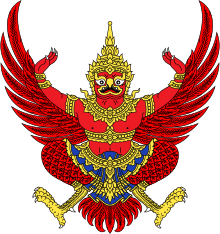Thai cuisine
Thai cuisine (Thai: อาหารไทย, rtgs: Ahan Thai, pronounced [ʔāː.hǎːn tʰāj]) is the national cuisine of Thailand. Balance, detail, and variety are of paramount significance to Thai chefs.
Thai cooking places emphasis on lightly prepared dishes with strong aromatic components and a spicy edge. It is known for its complex interplay of at least three and up to four or five fundamental taste senses in each dish or the overall meal: sour, sweet, salty, bitter, and spicy. Australian chef David Thompson, a prolific chef and expert on Thai food, observes that unlike many other cuisines,[1] Thai cooking rejects simplicity and is about "the juggling of disparate elements to create a harmonious finish".Thai chef McDang characterises Thai food as demonstrating "intricacy; attention to detail; texture; color; taste; and the use of ingredients with medicinal benefits, as well as good flavor", as well as care being given to the food's appearance, smell and context.[2]
Thai cuisine is one of the most popular cuisines in the world. In 2011, seven of Thailand's popular dishes appeared on the list of the "World's 50 Most Delicious Foods (Readers' Pick)"— a worldwide online poll of 35,000 people by CNN Travel. Thailand had more dishes on the list than any other country. They were: tom yam goong (4th), pad Thai (5th), som tam (6th), massaman curry (10th), green curry (19th), Thai fried rice (24th) and moo nam tok (36th).[3][4]
Regional cuisines and historical influences
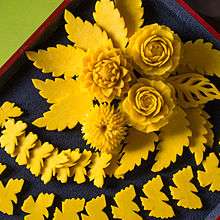
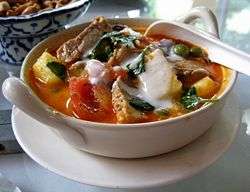

Thai cuisine is more accurately described as four regional cuisines, corresponding to the four main regions of the country:
- Central Thai cuisine of the flat and wet central rice-growing plains and of Bangkok, site of the former Thai kingdoms of Sukhothai and Ayutthaya, and the Dvaravati culture of the Mon people from before the arrival of Tai groups in the area.
- Isan or northeastern Thai cuisine of the more arid Khorat Plateau, similar in culture to Laos and also influenced by Khmer cuisine to its south, as evidenced by the temple ruins from the time of the Khmer Empire.
- Northern Thai cuisine of the verdant valleys and cool, forested mountains of the Thai highlands, once ruled by the former Lanna Kingdom and home to the majority of the ethnic groups of Thailand.
- Southern Thai cuisine of the Kra Isthmus which is bordered on two sides by tropical seas, with its many islands and including the ethnic Malay, former Sultanate of Pattani in the deep south.
Thai cuisine and the culinary traditions and cuisines of Thailand's neighbors have mutually influenced one another over the course of many centuries. Regional variations tend to correlate to neighboring states (often sharing the same cultural background and ethnicity on both sides of the border) as well as climate and geography. Northern Thai cuisine shares dishes with Shan State in Burma, northern Laos, and also with Yunnan Province in China, whereas the cuisine of Isan (northeastern Thailand) is similar to that of southern Laos, and is also influenced by Khmer cuisine from Cambodia to its south, and by Vietnamese cuisine to its east. Southern Thailand, with many dishes that contain liberal amounts of coconut milk and fresh turmeric, has that in common with Indian, Malaysian, and Indonesian cuisine.[6][7][8] In addition to these four regional cuisines, there is also the Thai royal cuisine which can trace its history back to the cosmopolitan palace cuisine of the Ayutthaya kingdom (1351–1767 CE). Its refinement, cooking techniques, presentation, and use of ingredients were of great influence to the cuisine of the central Thai plains.[9][10][11]
Many dishes that are now popular in Thailand were originally Chinese dishes. They were introduced to Thailand by the Hokkien people starting in the 15th century, and by the Teochew people who started settling in larger numbers from the late 18th century CE onward, mainly in the towns and cities, and now form the majority of the Thai Chinese.[12][13][14] Such dishes include chok Thai: โจ๊ก (rice porridge), salapao (steamed buns), kuaitiao rat na (fried rice-noodles) and khao kha mu (stewed pork with rice). The Chinese also introduced the use of a wok for cooking, the technique of deep-frying and stir frying dishes, several types of noodles, taochiao (fermented bean paste), soy sauces, and tofu.[15] The cuisines of India and Persia, brought first by traders, and later settlers from these regions, with their use of dried spices, gave rise to Thai adaptations and dishes such as kaeng kari (yellow curry)[16] and kaeng matsaman (massaman curry).[17][18]
Western influences, starting in 1511 CE when the first diplomatic mission from the Portuguese arrived at the court of Ayutthaya, have created dishes such as foi thong, the Thai adaptation of the Portuguese fios de ovos, and sangkhaya, where coconut milk replaces unavailable cow's milk in making a custard.[19] These dishes were said to have been brought to Thailand in the 17th century by Maria Guyomar de Pinha, a woman of mixed Japanese-Portuguese-Bengali ancestry who was born in Ayutthaya, and became the wife of Constantine Phaulkon, the Greek adviser of King Narai. The most notable influence from the West must be the introduction of the chili pepper from the Americas in the 16th or 17th century. It, and rice, are now two of the most important ingredients in Thai cuisine.[20] During the Columbian Exchange, Portuguese and Spanish ships brought new crops from the Americas including tomatoes, corn, papaya, pea eggplants, pineapple, pumpkins, culantro, cashews, and peanuts.
Serving
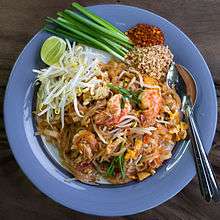

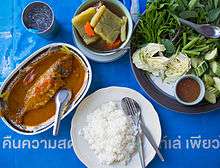
Thai food was traditionally eaten with the right hand [21][22] while seated on mats or carpets on the floor, customs still found in the more traditional households. Today, however, most Thais eat with a fork and spoon. Tables and chairs were introduced as part of a broader Westernization drive during the reign of King Mongkut, Rama IV. The fork and spoon were introduced by King Chulalongkorn after his return from a tour of Europe in 1897 CE.[23]
Important to Thai dining is the practice of khluk, mixing the flavors and textures of different dishes with the rice from one's plate. The food is pushed by the fork, held in the left hand, into the spoon held in the right hand, which is then brought to the mouth.[24] A traditional ceramic spoon is sometimes used for soup, and knives are not generally used at the table.[2] It is common practice for both the Thais and the hill tribe peoples who live in Lanna and Isan to use sticky rice as an edible implement by shaping it into small, and sometimes flattened, balls by hand (and only the right hand by custom) which are then dipped into side dishes and eaten.
Chopsticks were foreign utensils to most ethnic groups in Thailand with the exception of the Thai Chinese, and a few other cultures such as the Akha people, who are recent arrivals from Yunnan Province, China. Traditionally, the majority of ethnic Thai people ate with their hands like the people of India. Chopsticks are mainly used in Thailand for eating Chinese-style noodle soups, or at Chinese, Japanese, or Korean restaurants. Stir fried noodle dishes such as pad Thai, and curry-noodle dishes such as khanom chin nam ngiao, are also eaten with a fork and spoon in the Thai fashion.
Thai meals typically consist of rice (khao in Thai) with many complementary dishes shared by all. The dishes are all served at the same time, including the soups, and it is also customary to provide more dishes than there are guests at a table. A Thai family meal would normally consist of rice with several dishes which should form a harmonious contrast of flavors and textures as well as preparation methods. Traditionally, a meal would have at least five elements: a dip or relish for raw or cooked vegetables (khrueang chim) is the most crucial component of any Thai meal.[25][26] Khrueang chim, considered a building block of Thai food by Chef McDang, may come in the form of a spicy chili sauce or relish called nam phrik (made of raw or cooked chilies and other ingredients, which are then mashed together), or a type of dip enriched with coconut milk called lon. The other elements would include a clear soup (perhaps a spicy tom yam or a mellow tom chuet), a curry or stew (essentially any dish identified with the kaeng prefix), a deep-fried dish and a stir fried dish of meat, fish, seafood, or vegetables.
In most Thai restaurants, diners will have access to a selection of Thai sauces (nam chim) and condiments, either brought to the table by wait staff or present at the table in small containers. These may include: phrik nam pla/nam pla phrik (fish sauce, lime juice, chopped chilies and garlic), dried chili flakes, sweet chili sauce, sliced chili peppers in rice vinegar, Sriracha sauce, and even sugar. With certain dishes, such as khao kha mu (pork trotter stewed in soy sauce and served with rice), whole Thai peppers and raw garlic are served in addition to the sour chili sauce. Cucumber is sometimes eaten to cool the mouth with particularly spicy dishes. They often feature as a garnish, especially with one-dish meals. The plain rice, sticky rice or the khanom chin (Thai rice noodles) served alongside a spicy Thai curry or stir fry, tends to counteract the spiciness.
When time is limited or when eating alone, single dishes, such as fried rice or noodle soups, are quick and filling. An alternative is to have one or smaller helpings of curry, stir fries and other dishes served together on one plate with a portion of rice. This style of serving food is called khao rat kaeng (lit., "rice covered with curry"), or for short khao kaeng (lit., "rice curry"). Eateries and shops that specialize in pre-made food are the usual place to go to for having a meal this way. These venues have a large display showing the different dishes one can choose. When placing their order at these places, Thais will state if they want their food served as separate dishes, or together on one plate with rice (rat khao). Very often, regular restaurants will also feature a selection of freshly made "rice curry" dishes on their menu for single customers.
Ingredients


Thailand has about the same land area as Spain and a length of approximately 1,650 kilometers or 1,025 miles (Italy, in comparison, is about 1,250 kilometers or 775 miles long), with foothills of the Himalayas in the north, a high plateau in the northeast, a verdant river basin in the center, and tropical rainforests and islands in the south. With over 40 distinct ethnic groups each with its own culture and even more languages,[27] it comes as no surprise that Thai cuisine, as a whole, features many different ingredients (suan phasom; Thai: ส่วนผสม), and ways of preparing food.
Thai food is known for its enthusiastic use of fresh (rather than dried) herbs and spices. Common flavors in Thai food come from garlic, galangal, coriander/cilantro, lemon grass, shallots, pepper, kaffir lime leaves, shrimp paste, fish sauce, and chilies. Palm sugar, made from the sap of certain Borassus palms, is used to sweeten dishes while lime and tamarind contribute sour notes. Meats used in Thai cuisine are usually pork and chicken, and also duck, beef, and water buffalo. Goat and mutton are rarely eaten except by Muslim Thais. Game, such as wild boar, deer and wild birds, are now less common due to loss of habitat, the introduction of modern methods of intensive animal farming in the 1960s, and the rise of agribusinesses, such as Thai Charoen Pokphand Foods, in the 1980s.[28] Traditionally, fish, crustaceans, and shellfish play an important role in the diet of Thai people.[29] Anna Leonowens (of The King and I fame) observed in her book The English Governess at the Siamese Court (1870):[30]
"The stream is rich in fish of excellent quality and flavour, such as is found in most of the great rivers of Asia; and is especially noted for its platoo, a kind of sardine, so abundant and cheap that it forms a common seasoning to the labourer's bowl of rice."
Freshwater varieties come from the many rivers, lakes, ponds, and paddy fields inland, and seafood from the tropical seas of the southern half of the country. Some species, such as the giant river prawn, need brackish water as juveniles but live out their lives in freshwater once mature. Aquaculture of species such as Nile tilapia, catfish, tiger prawns, and blood cockles, now generates a large portion of the seafood sold in, and exported from Thailand.[31]
Rice, noodles and starches
Like most other Asian cuisines, rice is the staple grain of Thai cuisine. According to Thai food expert McDang, rice is the first and most important part of any meal, and the words for rice and food are the same: khao. As in many other rice eating cultures, to say "eat rice" (in Thai "kin khao"; pronounced as "keen cow") means to eat food. Rice is such an integral part of the diet that a common Thai greeting is "kin khao reu yang?" which literally translates as "Have you eaten rice yet?".[32]
Thai farmers historically have cultivated tens of thousands of rice varieties. The traditional recipe for a rice dish could include as many as 30 varieties of rice.[33] That number has been drastically reduced due to genetic modifications.
Non-glutinous rice (Oryza sativa) is called khao chao (lit., "princely rice"). One type, which is indigenous to Thailand, is the highly prized, sweet-smelling jasmine rice (khao hom Mali). This naturally aromatic long-grained rice grows in abundance in the patchwork of paddy fields that blanket Thailand's central plains. Once the rice is steamed or cooked, it is called khao suai (lit., "beautiful rice"). Non-glutinous rice is used for making fried rice dishes, and for congee, of which there are three main varieties: khao tom (a thin rice soup, most often with minced pork or fish), khao tom kui (a thick, unflavored rice porridge that is served with side dishes), or chok (a thick rice porridge that is flavored with broth and minced meat).
Other varieties of rice eaten in Thailand include: sticky rice (khao niao), a unique variety of rice which contains an unusual balance of the starches present in all rice, causing it to cook up to a sticky texture. Sticky rice, not jasmine rice, is a staple food in the local cuisines of northern Thailand and of Isan (northeastern Thailand), both regions of Thailand directly adjacent to Laos with which they share many cultural traits. Thai Red Cargo rice, an unpolished long grain rice with an outer deep reddish-brown color and a white center, has a nutty taste and slightly chewy compared to the soft and gummy texture of jasmine rice. Only the husks of the red rice grains are removed which allows it to retain all its nutrients and vitamins, but unlike brown rice, its red color comes from antioxidants in the bran. Black sticky rice is a type of sticky rice with a deep purple-red color that may appear black. Another unpolished grain, black sticky rice has a rich nutty flavor that is most often used in desserts.
Noodles are usually made from either rice flour, wheat flour or mung bean flour. Khanom chin is fresh rice vermicelli made from fermented rice, and eaten with spicy curries such as green chicken curry (khanom chin kaeng khiao wan kai) or with salads such as som tam. Other rice noodles, adapted from Chinese cuisine to suit Thai taste, are called kuaitiao in Thailand and come in three varieties: sen yai are wide flat noodles, sen lek are thin flat rice noodles, and sen mi (also known as rice vermicelli in the West) are round and thin. Bami is made from egg and wheat flour and usually sold fresh. They are similar to the Teochew mee pok. Wun sen, called cellophane noodles in English, are extremely thin noodles made from mung bean flour which are sold dried. Thai noodle dishes, whether stir fried like phat Thai or in the form of a noodle soup, usually come as an individual serving and are not meant to be shared and eaten communally.
Rice flour (paeng khao chao) and tapioca flour (paeng man sampalang) are often used in desserts or as thickening agents.
Pastes and sauces

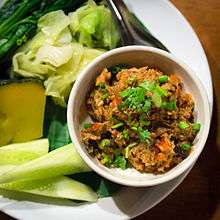
An ingredient found in many Thai dishes and used in every region of the country is nam pla, a clear fish sauce that is very aromatic. Fish sauce is a staple ingredient in Thai cuisine and imparts a unique character to Thai food. Fish sauce is prepared with fermented fish that is made into a fragrant condiment and provides a salty flavor. There are many varieties of fish sauce and many variations in the way it is prepared. Some fish may be fermented with shrimp or spices. Another type of sauce made from fermented fish is pla ra. It is more pungent than nam pla, and, in contrast to nam pla, which is a clear liquid, pla ra is opaque and often contains pieces of fish. To add this sauce to a som tam (spicy papaya salad) is a matter of choice. Kapi, Thai shrimp paste, is a combination of fermented ground shrimp and salt. It is used in the famous chili paste called nam phrik kapi, in rice dishes such as khao khluk kapi and it is indispensable for making Thai curry pastes. Tai pla is a pungent sauce used in the southern Thai cuisine, that is made from the fermented innards of the shortbodied mackerel (pla thu).[34] It is one of the main condiments of kaeng tai pla curry and is also used to make nam phrik tai pla.[35] Far removed from the nearest sea, from northern Thailand comes nam pu, a thick, black paste made by boiling mashed rice-paddy crabs for hours. It is used as an ingredient for certain northern Thai salads, curries, and chili pastes. It too has a strong and pungent flavor.[36]
Nam phrik are Thai chili pastes, similar to the Indonesian and Malaysian sambals. Each region has its own special versions. The words "nam phrik" are used by Thais to describe many pastes containing chilies used for dipping, although the more watery versions tend to be called nam chim. Thai curry pastes are normally called phrik kaeng or khrueang kaeng (lit. curry ingredients), but some people also use the word nam phrik to designate a curry paste. Red curry paste, for instance, could be called phrik kaeng phet or khrueang kaeng phet in Thai, but also nam phrik kaeng phet. Both nam phrik and phrik kaeng are prepared by crushing together chilies with various ingredients such as garlic and shrimp paste using a mortar and pestle. Some nam phrik are served as a dip with vegetables such as cucumbers, cabbage and yard-long beans, either raw or blanched. One such paste is nam phrik num, a paste of pounded fresh green chilies, shallots, garlic and coriander leaves. The sweet roasted chili paste called nam phrik phao is often used as an ingredient in tom yam or when frying meat or seafood, and it is also popular as a spicy "jam" on bread, or served as a dip with prawn crackers. The dry nam phrik kung, made with pounded dried shrimp (kung haeng), is often eaten plain with rice and a few slices of cucumber. French diplomat Simon de la Loubère observed that chili pastes were vital for the way Thai people eat. He provides us with a recipe for nam phrik with pla ra and onions in Du Royaume de Siam, an account of his mission to Thailand published in 1691.[37]
The soy sauces which are used in Thai cuisine are of Chinese origin, and the Thai names for them are (wholly or partially) loanwords from the Teochew dialect: si-io dam (dark soy sauce), si-io khao (light soy sauce), si-io wan (sweet soy sauce), and taochiao (fermented whole soy beans). Namman hoi (oyster sauce) is also of Chinese origin. It is used extensively in vegetable and meat stir fries.
Vegetables, herbs and spices



Thai dishes use a wide variety of herbs, spices and leaves rarely found in the West. The characteristic flavor of kaffir lime leaves (bai makrut) appears in many Thai soups (e.g., the hot and sour tom yam) or curry from the southern and central areas of Thailand. The Thai lime (manao) is smaller, darker and sweeter than the kaffir lime, which has a rough looking skin with a stronger lime flavor. Kaffir lime leaves or rind is frequently combined with galangal (kha) and lemongrass (takhrai), either kept whole in simmered dishes or blended together with liberal amounts of chilies and other aromatics to make curry paste. Fresh Thai basil, redolent with a distinctive scent reminiscent of cloves and stems which are often tinged with a purple color, are used to add fragrance in certain dishes such as green curry. Other commonly used herbs in Thai cuisine include phak chi, (coriander or cilantro leaves), rak phak chi (cilantro/coriander roots), spearmint (saranae), holy basil (kraphao), ginger (khing), turmeric (khamin), fingerroot (krachai), culantro (phak chi farang), pandanus leaves (bai toei), and Thai lemon basil (maenglak). Spices and spice mixtures used in Thai cuisine include phong phalo (five-spice powder), phong kari (curry powder), and fresh and dried peppercorns (phrik thai). Northern Thai larb uses a very elaborate spice mix, called phrik lap, which includes ingredients such as cumin, cloves, long pepper, star anise, prickly ash seeds and cinnamon.[38]
Besides kaffir lime leaves, several other tree leaves are used in Thai cuisine such as cha-om, the young feathery leaves of the Acacia pennata tree. These leaves can be cooked in omelettes, soups and curries or eaten raw in northern Thai salads. Banana leaves are often used as packaging for ready-made food or as steamer cups such as in ho mok pla, a spicy steamed pâté or soufflé made with fish and coconut milk. Banana flowers are also used in Thai salads or as a vegetable ingredient for certain curries. The leaves and flowers of the neem tree (sadao) are also eaten blanched. Phak lueat (leaves from the Ficus virens) are cooked in curries, and bai makok (from the Spondias mombin) can be eaten raw with a chili paste.
Five main chilies are generally used as ingredients in Thai food. One chili is very small (about 1.25 centimetres (0.49 in)) and is known as the hottest chili: phrik khi nu suan ("garden mouse-dropping chili"). The slightly larger chili phrik khi nu ("mouse-dropping chili") is the next hottest. The green or red phrik chi fa ("sky pointing chili") is slightly less spicy than the smaller chilies. The very large phrik yuak, which is pale green in color, is the least spicy and used more as a vegetable. Lastly, the dried chilies: phrik haeng are spicier than the two largest chilies and dried to a dark red color.
Other typical ingredients are the several types of eggplant (makhuea) used in Thai cuisine, such as the pea-sized makhuea phuang and the egg-sized makhuea suai, often also eaten raw. Although broccoli is often used in Asian restaurants in the west in phat phak ruam (stir fried mixed vegetables) and rat na (rice noodles served in gravy), it was never used in any traditional Thai food in Thailand and is still rarely seen in Thailand. Usually in Thailand, khana is used, for which broccoli is a substitute. Other vegetables which are often eaten in Thailand are thua fak yao (yardlong beans), thua ngok (bean sprouts), no mai (bamboo shoots), tomatoes, cucumbers, phak tam lueng (Coccinia grandis), phak kha na (Chinese kale), phak kwangtung (choy sum), sweet potatoes (both the tuber and leaves), a few types of squash, phak krathin (Leucaena leucocephala), sato (Parkia speciosa), tua phū (winged beans) and khaophot (corn).
Among the green, leafy vegetables and herbs that are usually eaten raw in a meal or as a side dish in Thailand, the most important are: phak bung (morning glory), horapha (Thai basil), bai bua bok (Asian pennywort), phak kachet (water mimosa), phak kat khao (Chinese cabbage), phak phai (praew leaves), phak kayang (rice paddy herb), phak chi farang (culantro), phak tiu (Cratoxylum formosum), phak "phaai" (yellow burr head) and kalamplī (cabbage).[39] Some of these leaves are highly perishable and must be used within a couple of days.
Several types of mushroom (het) also feature in Thai cuisine such as straw mushrooms (het fang), shiitake (het hom), and white jelly fungus (het hu nu khao).[40]
Flowers are also commonly used ingredients in many Thai dishes, either as a vegetable, such as dok khae (Sesbania grandiflora) and huapli (the flower bud of the banana), or as a food coloring, such as with the blue-colored dok anchan (the flowers of the Clitoria ternatea, which can also be eaten raw or fried).
Fruits
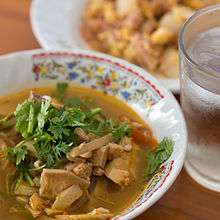
Fresh fruit forms a large part of the Thai diet, and are customarily served after a meal as dessert. The Scottish author John Crawfurd, sent on an embassy to Bangkok in 1822, writes in his account of the journey:
"The fruits of Siam, or at least of the neighbourhood of Bangkok, are excellent and various, surpassing, according to the experience of our party (...) those of all other parts of India."[41] The Siamese themselves consume great quantities of fruit, and the whole neighbourhood of Bangkok is one forest of fruit trees.[42]
Fruit is not only eaten on its own, but often served with spicy dips made from sugar, salt, and chilies.[43] Fruits feature in spicy salads such as som tam (green papaya salad) and yam som-o (pomelo salad), in soups with tamarind juice such as tom khlong and kaeng som, and in Thai curries such as kaeng kanun (jackfruit curry), kaeng pet phet yang (grilled duck curry with pineapple or grapes), and kaeng pla sapparot (fish and pineapple curry). Fruits are also used in certain Thai chili pastes, such as in nam phrik long rue made with madan (a close relative of the mangosteen),[44] and nam phrik luk nam liap, made with the fruit of the Chinese olive.[45]
Although many of the exotic fruits of Thailand may have been sometimes unavailable in Western countries, Asian markets now import such fruits as rambutan and lychees. In Thailand one can find papaya, jackfruit, mango, mangosteen, langsat, longan, pomelo, pineapple, rose apples, durian, Burmese grapes and other native fruits. Chantaburi in Thailand each year holds the World Durian Festival in early May. This single province is responsible for half of the durian production of Thailand and a quarter of the world production.[46][47][48] The Langsat Festival is held each year in Uttaradit on weekends in September. The langsat (Lansium parasiticum), for which Uttaradit is famous, is a fruit that is similar in taste to the longan.[49]
From the coconut comes coconut milk, used both in curries and desserts, and coconut oil. The juice of a green coconut can be served as a drink and the young flesh is eaten in either sweet or savory dishes. The grated flesh of a mature coconut is used raw or toasted in sweets, salads and snacks such as miang kham.[50] Thais not only consume products derived from the nut (actually a drupe), but they also make use of the growth bud of the palm tree as a vegetable. From the stalk of the flowers comes a sap that can be used to make coconut vinegar, alcoholic beverages, and sugar. Coconut milk and other coconut-derived ingredients feature heavily in the cuisines of central and southern Thailand. In contrast to these regions, coconut palms do not grow as well in northern and northeastern Thailand, where in wintertime the temperatures are lower and where there is a dry season that can last five to six months. In northern Thai cuisine, only a few dishes, most notably the noodle soup khao soi, use coconut milk. In the southern parts of northeastern Thailand, where the region borders Cambodia, one can again find dishes containing coconut. It is also here that the people eat non-glutinous rice, just as in central and southern Thailand, and not glutinous rice as they do in northern Thailand and in the rest of northeastern Thailand.[51][52]
Apples, pears, peaches, grapes, and strawberries, which do not traditionally grow in Thailand and in the past had to be imported, have become increasingly popular in the last few decades since they were introduced to Thai farmers by the Thai Royal Projects, starting in 1969, and the Doi Tung Project since 1988. These temperate fruit grow especially well in the cooler, northern Thai highlands, where they were initially introduced as a replacement for the cultivation of opium, together with other crops such as cabbages, tea, and aribica coffee.
Food controversies
Agricultural chemicals
According to the Thai government's The Eleventh National Economic and Social Development Plan (2012-1016), Thailand is number one in the world in the application of chemicals in agriculture. The report stated that, "The use of chemicals in the agricultural and industrial sectors is growing while control mechanisms are ineffective making Thailand rank first in the world in the use of registered chemicals in agriculture."[53]:111
The Thai Pesticide Alert Network (Thai-PAN), a food safety advocacy group, regularly tests Thai farm produce for contamination. In their August 2016 evaluation, the group found that of 158 samples, 56 percent of produce was found to have unsafe levels of chemicals. A spokesperson for the group said that 70.2 percent of the produce from supermarkets was contaminated. Chinese kale topped the list of contaminated vegetables with 10 out of 11 samples containing residues. Red chillies (9 of 12) came in second, followed by cowpeas and basil (8 of 12), morning glory (7 of 12), small eggplants (6 of 11), cucumbers (5 of 11), tomatoes (3 of 11), cabbage (2 of 11), and Chinese cabbage (2 of 12). Among fruits, Sai Nam Phueng oranges were most contaminated as traces of chemicals were found in all eight samples. They were followed by dragon fruit (7 of 8), guava (6 of 7), papaya (3 of 6), watermelon (3 of 7), and cantaloupe (1 of 7).[54]
"Q-Mark" goods showed a higher prevalence of contamination, 61.5 percent, than they did during Thai-PAN's March 2016 survey, 57 percent. Q-Mark is the National Bureau of Agricultural Commodity and Food Standards (ACFS) mark of quality.[55][56]
Misrepresentation
- In September 2016 a shipment of pork labelled "halal"—a permissible food for Muslims—was delivered to a hotel in Krabi Province. The Central Islamic Committee of Thailand (CICOT) denounced the use of a halal-certified logo on pork, saying it will take legal action against people responsible. The committee found the halal label to be fake. Under Thai laws, CICOT is responsible for certifying halal products.[57]
- A survey of the quality of fish sauce on sale across Thailand reported that just over one-third of the samples were not up to standards set by the Public Health Ministry. The three-year survey, from 2012 to 2015, involved 1,121 samples of fish sauce sold under 422 brands from 245 manufacturers. Of the total analysed, 410 samples, or 36.5 percent, did not meet the standard. The major reasons for the substandard fish sauce were low nitrogen readings and the ratio of glutamic acid to nitrogen either higher or lower than the required standards.[58]
Representative dishes
Whereas many Thai dishes are now familiar in the West, the vast majority are not. In many of the dishes below, different kinds of protein, or combinations of protein, are interchangeable as the main ingredient. Beef (nuea), chicken (kai), pork (mu), duck (pet), tofu (taohu), fish (pla), prawns or shrimp (kung), crab (pu), shellfish (hoi), or egg (khai) can, for example, all be used as main ingredients for kaeng phet (red curry). Kaeng phet kai will be red curry with chicken, kaeng phet mu with pork, etc..
Breakfast dishes
Khao chao (Thai: ข้าวเช้า; lit. "morning rice/food"), breakfast dishes, for Thais are limited. Very often, a Thai breakfast can consist of the same dishes with rice which are also eaten for lunch or dinner. Single dishes such as fried rice, noodle soups, and steamed rice with something simple such as an omelette, fried/grilled pork or chicken, or a stir fry with vegetables, are commonly sold for breakfast from street stalls as a quick take-out.
The following dishes are viewed as being specific breakfast dishes but they can also be found at any other moment of the day:[59][60]
- Chok - a rice porridge commonly eaten in Thailand for breakfast. Similar to the rice congee eaten in other parts of Asia.
- Khao khai chiao - an omelet (khai chiao) with white rice, often eaten with a chili sauce and slices of cucumber.
- Khao tom - a Thai style rice soup, usually with pork, chicken, fish, or shrimp.
- Pathongko - The Thai version of the Chinese deep-fried bread called youtiao. It can be topped up with spreads such as sangkhaya or with chocolate and sweetened condensed milk.[61]
- Nam taohu - Soy milk which is often served with sweet jellies.
Individual dishes
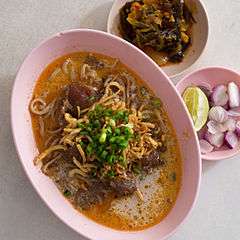
Known as ahan chan diao (Thai: อาหารจานเดียว; lit., "single dish food"), it is not only the name for true single plate dishes, but also for dishes that are served "rat khao" (lit., "poured on rice"): one or more dishes are served together with rice on one plate. Some of these eateries offer a large selection of (pre-cooked) dishes, others are specialized in only a one, or a few dishes with rice.
- Kaphrao mu rat khao - minced pork fried with chilies, garlic, soy sauce and holy basil, served together with rice, and with nam pla phrik as a condiment.
- Khanom chin kaeng kiao wan kai - fresh Thai rice noodles (khanom chin) served in a bowl with green chicken curry as a sauce. Raw vegetables, herbs, and fish sauce are served on the side and can be added to taste.
- Khanom chin nam ngiao - A specialty of northern Thailand, it is Thai fermented rice noodles served with pork blood tofu and raw vegetables, in a sauce made with pork broth and tomato, crushed fried dry chilies, chicken blood, dry fermented soy bean, and dried red kapok flowers.[62]
- Khanom chin namya - round boiled rice noodles topped with a fish-based sauce and eaten with fresh leaves and vegetables.
- Khao kha mu - steamed rice served with red cooked pork leg, steamed mustard greens, pickled cabbage, sweet-sour chili sauce, raw garlic, fresh bird's eye chilies, and boiled egg.
- Khao khluk kapi - rice stir fried with shrimp paste, served with sweetened pork and vegetables.
- Khao man kai - rice steamed in chicken stock with garlic, with boiled chicken, chicken stock, and a spicy dipping sauce. It is usually served with a bowl of radish soup, or nam kaeng hua chai thao.
- Khao mu daeng - slices of Thai-style Chinese char siu is served with rice, sliced cucumber, and a thickened gravy. This often comes with a bowl of broth and a few stalks of raw scallions. Thick, black soy sauce with sliced chilies is used as condiment.
- Khao na pet - rice served with slices of red-roast duck, sliced cucumber, and a thickened gravy. It is served with the same spicy soy sauce condiment as aforementioned khao mu daeng and also often comes with a bowl of soup, and additional stalks of raw scallions.
- Khao phat - One of the most common rice dishes in Thailand. Usually with chicken, beef, shrimp, pork, crab, coconut or pineapple, or vegetarian (che; Thai: เจ).
- Khao phat American - although devised in Thailand, it is called "American-style" fried rice because the rice is fried with tomato ketchup, may contain raisins, and is served with a fried egg, hot dogs, and bacon, which were all viewed as being typically American ingredients.
- Khao phat kai - fried rice with chicken.
- Khao phat mu - fried rice with pork.
- Khao phat pu - fried rice with crab meat.
- Khao phat kung - fried rice with shrimp.
- Khao phat naem - fried rice with fermented sausage (naem, a typically sausage from the northeast, it is similar to the Vietnamese nem chua).
- Khao soi - curried noodle soup enriched with coconut milk (traditionally a novel ingredient in the cooking traditions of northern Thailand), garnished with crispy fried wheat noodles, and served with pickled cabbage, lime, a chili paste, and raw shallots on the side. Arguably Chiang Mai's most iconic dish, it was originally a dish of the Chin Haw, Chinese-Muslim traders from Yunnan Province in China. Northern Thai khao soi is different from the Lao version.
- Kuaitiao nam and bami nam - noodle soup can be eaten at any time of day; served with many combinations of proteins, vegetables, and spicy condiments. The word kuaitiao, although originally designating only sen yai (wide rice noodles), is now used colloquially for rice noodles in general: sen mi (rice vermicelli), sen lek (narrow rice noodles) and the aforementioned sen yai. The yellow egg noodles are called bami. Four condiments are usually provided on the table: sugar, fish sauce, chili flakes, and sliced chilies in vinegar.
- Kuaitiao luk chin pla - noodle soup with fish balls.
- Bami mu daeng - egg noodles with Thai-style char siu.
- Kuaitiao rat na - wide rice noodles covered in a gravy, with beef, pork, chicken, shrimp, or seafood.
- Mi krop - deep fried rice vermicelli with a sweet and sour sauce.
- Phat khi mao - noodles stir fried with chilies and holy basil.
- Phat si-io - rice noodles (often kuai tiao) stir fried with si-io dam (thick sweet soy sauce) and nam pla (fish sauce) and pork or chicken.
- Phat Thai - rice noodles pan fried with fish sauce, sugar, lime juice or tamarind pulp, chopped peanuts, and egg combined with chicken, seafood, or tofu. It is listed at number five on the World's 50 most delicious foods readers' poll compiled by CNNGo in 2011.
Central Thai shared dishes

Ahan Phak Klang (Thai: อาหารภาคกลาง; lit. "central region food") is most often eaten with the non-glutinous jasmine rice. The cuisine has also incorporated many Thai Chinese dishes.
- Chuchi pla kaphong - snapper in chuchi curry sauce (thick red curry sauce)
- Kai phat khing - chicken stir fried with sliced ginger.
- Kaeng khiao wan - called "green curry" in English, it is a coconut curry made with fresh green chillies and flavoured with Thai basil, and chicken or fish meatballs. This dish can be one of the spiciest of Thai curries.
- Ho mok pla - a pâté or soufflé of fish, spices, coconut milk and egg, steamed in a banana leaf cup and topped with thick coconut cream before serving.
- Kaeng phanaeng - a mild creamy coconut curry with beef (phanaeng nuea), chicken, or pork. It includes some roasted dried spices similar to kaeng matsaman.
- Kaeng phet (lit. 'spicy curry') - also known as red curry in English, it is a coconut curry made with copious amounts of dried red chillies in the curry paste.
- Kaeng som - a hot and sour soup/curry usually eaten together with rice
- Kai phat met mamuang himmaphan - The Thai Chinese version of the Sichuan style chicken with cashews known as kung Pao chicken, fried with whole dried chilies.
- Miang kham - dried shrimp and other ingredients wrapped in cha plu leaves; often eaten as a snack or a starter.
- Phak bung fai daeng - stir fried morning glory with yellow bean paste.
- Phat khana mu krop - khana (gailan) stir fried with crispy pork.
- Phat kaphrao - beef, pork, prawns, or chicken stir fried with Thai holy basil, chillies, garlic, and soy sauce; for instance mu phat kaphrao /kaphrao mu with minced pork.
- Phat phak ruam - stir fried combination of vegetables depending on availability and preference.
- Phat phrik - often eaten as nuea phat phrik: beef stir fried with chilli.
- Pla nueng manao - steamed fish with a spicy lime juice dressing.
- Pla sam rot – literally, "three flavours fish": deep fried fish with a sweet, tangy and spicy tamarind sauce.
- Pu cha - a mixture of cooked crab meat, pork, garlic and pepper, deep fried inside the crab shells and served with a simple spicy sauce, such as Sriracha sauce, sweet-hot garlic sauce, nam phrik phao (roasted chilli paste), nam chim buai (plum sauce), or in a red curry paste, with chopped green onions. It is sometimes also served as deep fried patties instead of being fried in the crab shell.
- Suki - a Thai variant of the Chinese hot pot.
- Thot man - deep fried fishcake made from knifefish (thot man pla krai) or shrimp (thot man kung).
- Tom chuet or kaeng chuet - a clear soup with vegetables and, for instance, wunsen (cellophane noodles), taohu (silken tofu), mu sap (minced pork), or het (mushrooms). It is of Thai Chinese origin.
- Tom kha kai - hot spicy soup with coconut milk, galangal, and chicken.
- Tom yam - hot & sour soup with meat. With shrimp it is called tom yam goong or tom yam kung, with seafood (typically shrimp, squid, fish) tom yam thale, with chicken tom yam kai.
- Yam - general name for many different kinds of sour Thai salads, such as those made with glass noodles (yam wunsen), with seafood (yam thale), or grilled beef (yam nuea). The dressing of a "yam" will normally consist of shallots, fish sauce, tomato, lime juice, sugar, chilies and Thai celery (khuenchai), or coriander.
- Yam pla duk fu - crispy fried catfish with a spicy, sweet-and-sour, green mango salad.
Northeastern shared dishes
Ahan Isan (Thai: อาหารอีสาน; lit. "Isan food") generally features dishes similar to those found in Laos, as Isan people historically have close ties with Lao culture and speak a language that is generally mutually intelligible with the Lao language. The staple food of Isan is glutinous rice and most of the Isaan food is spicy and cooked with local ingredients found on the farms all through northeastern Thailand. Isaan people primarily get their income from farming. Rice, sugar cane, pineapple, potato, and rubber are all farmed in this region.
- Snail Curry - Kaeng Khae Hoi - Kaeng khae hoi or kaeng khao khua hoi requires the same ingredients as kaeng khae except for using snails instead of chicken. Roasted ground rice thickens the liquid.[63]
- Namphrik pla – fish chili sauce - Namphrik pla or fish chili sauce can be a little thick or thin depending on the amount of liquid from the boiling fish one puts in it. Grilled fish can be used instead of boiled fish. Any kinds of fresh chilies can be used from mild to the hottest kinds to suit one's taste. It goes well with water clover, tips of lead tree greens, or crispy eggplant.[63]
- Lap kai - Lap kai requires minced chicken meat and fresh chicken blood mixed with chili paste for lap made from roasted dried chilies and spices. It is usually eaten with a variety of vegetables and herbs that are pungent known as "phak kap lap". Lap dip refers to the uncooked kind. "Lap suk" is the cooked version which is stir fried with a little oil and water.[63]
- Yam tao – paddy crabs in algae with eggplant - Yam tao or tam tao is made from fresh water algae grown in paddy fields in Isaan and 2-3 kinds of sliced eggplant with boiled crabs and ginger leaves as well as fresh bird chilies.[64]
- Tam khai mot daeng – ant eggs and roasted vegetables - Tam khai mot daeng is made the same as other kinds of "tam" dishes with roasted long peppers and two kinds of chopped mint to enhance the flavor. Shrimp paste is not used in this recipe.[65]
- Namphrik nam oi – brown sugar chili sauce - Isan brown cane sugar sauce is good as a dip for such sour tasting fruit as green mangoes, mango plums, or tamarinds.[66]
- Namphrik nam pu – crab and chili Sauce - Namphrik nam pu is rather thick to almost dry. Many kinds of fresh chilies can be used also. Including smoked chilies. Because crabs are abundant in the rice fields of northeast Thailand, this is a common dish.[67]
- Water Beetle and Chili Dip – Namphrik maeng da - This is a rather dry or very thick kind of chili dish. Any kind of chilies (preferably fresh) can be used. Other kinds of edible beetles or wasps or bees can be used instead of the maeng da. Because of the pungent odor of the maeng da, garlic should be left out.[64]
- Yam phak kum dong – pickled phak kum leaf - The greens of phak kum have to be pickled for at least three days the same way as pickling mustard greens (phak kat). This recipe calls for roasted dried chilies.[64]
- No o - pickled bamboo shoots – No o refers to bamboo shoots that have a strong smell by the process of quick pickling (2–3 days). Some recipes pickle the shoots with the peels and take off the peel just before boiling. Boiling should be rather long for a good result.[68]
- Mola Crickets and Chili Dip – Namphrik maeng chon - This kind of chili dish is rather dry and very thick. Use fresh chilies of any kind. Other kinds of edible insects or larvae can be used instead of mola crickets which will be called by the name of the insects used as the main ingredients such as wasp, grasshopper, or bee larvae (namphrik to, namphrik taen and namphrik phueng).[64]
- Kai mot daeng - clean and high in protein nutrients. Red ants eat mango leaves so their bodies taste like a squirt of lime, but their fresh eggs are fatty and sweet.
- Kai yang - marinated, grilled chicken.
- Khao niao - Sticky rice is eaten as a staple food both in the northeast as in the north of Thailand. It is traditionally steamed.
- Lap - a traditional Lao salad containing meat, onions, chillies, roasted rice powder, and garnished with mint.
- Mu ping - marinated, grilled pork on a stick.
- Nam chim chaeo - is a sticky, sweet and spicy dipping sauce made with dried chilies, fish sauce, palm sugar, and black roasted rice flour. It is often served as a dip with mu yang (grilled pork).
- Nam tok - made with pork (mu) or beef (nuea) and somewhat identical to lap, except that the pork or beef is cut into thin strips rather than minced.
- Phat mi Khorat - a stir fried rice noodle dish commonly served with papaya salad in Thailand. Dried rice noodles of many colors are a specific ingredient for this dish.
- Som tam - grated green papaya salad, pounded with a mortar and pestle, similar to the Lao tam mak hoong. There are three main variations: som tam pu with pickled rice-paddy crab, and som tam Thai with peanuts, dried shrimp and palm sugar and som tam pla ra from the northeastern part of Thailand (Isan), with salted gourami fish, white eggplants, fish sauce and long beans. Som tam is usually eaten with sticky rice but a popular variation is to serve it with khanom chin (rice noodles) instead.
- Suea rong hai - grilled beef brisket.
- Tom saep - Northeastern-style hot and sour soup.
- Yam naem khao thot or naem khluk - a salad made of crumbled rice-and-curry croquettes and sour pork sausage.
Northern shared dishes
Ahan Lanna (Thai: อาหารล้านนา; lit. "Lanna food") shares certain dishes with neighboring Shan State, in Burma, and with northern Laos. As in northeastern Thailand, glutinous rice, not jasmine rice, is eaten as the staple food.
- Aep - Slow-grilled wrapped in banana leaves, this dish is most often made with chopped meat, small fish or edible insects, mixed with beaten eggs and spices.
- Kaeng hang-le - a Burmese-influenced stewed pork curry which uses peanuts, dried chilies, tamarind juice and curry paste in the recipe, but containing no coconut milk.
- Kaeng khae - is a spicy northern Thai curry of herbs, vegetables, the leaves of an acacia tree (cha-om) and meat (chicken, water buffalo, pork or frog). It also does not contain any coconut milk.
- Kaeng khanun - a curry of pork stewed with green jackfruit, which is very popular in the region. Like all northern Thai curries, it does not contain any coconut milk.
- Kaeng pa - better known as "jungle curry" internationally. Traditionally made with wild boar, most often pork or chicken is used nowadays.
- Kaep mu - deep fried crispy pork rinds which often eaten with chili pastes such as nam phrik num but also eaten as a snack on their own.
- Larb Lanna - drier and smokier in taste, northern Thai larb does not contain lime or fish sauce. Instead it's flavoured and seasoned with an elaborate mix of ground dried chillies, dried spices like cumin, cloves, long pepper, star anise, Sichuan pepper, cinnamon, and occasionally blood of the animal used.
- Nam phrik kha - thick relish made with roasted chilies, garlic, galangal, and salt. This northern Thai specialty is often served as a dip for steamed mushrooms or steamed sliced beef shank.
- Nam phrik num - a chili paste of pounded large green chilies, shallots, garlic, coriander leaves, lime juice and fish sauce; eaten with steamed and raw vegetables, and sticky rice.
- Nam phrik ong - resembling a thick Bolognese sauce, it is made with dried chilies, minced pork, fermented soy beans, and tomato; eaten with steamed and raw vegetables, and sticky rice.
- Sai ua - a grilled sausage of ground pork mixed with spices and herbs; it is often served with chopped fresh ginger and chilies at a meal. It is also sold at markets in Chiang Mai as a snack.
- Tam som-o - a salad made from the slightly pounded flesh of a pomelo fruit, which is mixed with garlic, sliced lemongrass, and a thick pungent black paste (nam pu) made from boiling down the juices and meat of rice-paddy crab.
Southern shared dishes
Ahan Phak Tai (Thai: อาหารภาคใต้; lit. "southern region food") shares certain dishes with the cuisine of northern Malaysia. Southern Thais, just like the people of central Thailand to the north, and the people of Malaysia to the south, eat non-glutinous rice as their staple food.
- Kaeng matsaman - also known in English as Massaman curry, it is an Indian style curry, usually made by Thai-Muslims, of stewed beef and containing roasted dried spices, such as coriander seed, that are rarely found in other Thai curries. In 2011 CNNGo ranked massaman as number one in an article titled World's 50 most delicious foods.
- Kaeng som (Southern Thai name) or kaeng lueang (central Thai name) - a sour curry with fish, vegetables or fruit
- Kaeng tai pla - a thick sour vegetable curry made with turmeric and shrimp paste, often containing roasted fish or fish innards, bamboo shoots, and eggplant.
- Khao mok - Thai-style biryani, a specialty of southern Thailand's Muslim community.
- Khao yam - a rice salad from southern Thailand.[7]
- Khua kling - a very dry spicy curry made with minced or diced meat with sometimes yard long beans added to it; often served with fresh green phrik khi nu (thai chilies) and copious amounts of finely shredded bai makrut (kaffir lime leaves).
- Sate - grilled meat, usually pork or chicken, served with cucumber salad and peanut sauce (actually of Indonesian origin, but now a popular street food in Thailand).
Desserts and sweets
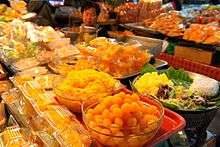
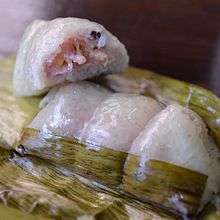
Khong wan
(Thai: ของหวาน; rtgs: khong wan) lit. "sweet things"). Although most Thai meals finish with fresh fruit, sometimes sweet snacks, often eaten between meals, will also be served as a dessert.
- Chaokuai - grass jelly is often served with only shaved ice and brown sugar.
- Kanom khrok - coconut-rice pancakes, one of the ancient Thai desserts
- Khao tom mat - a traditional Thai dessert prepared from sticky rice, coconut milk, and banana.
- Khanom bua loi – mashed taro root and pumpkin are mixed with rice flour into small balls, boiled and then served in coconut milk.
- Khanom chan – multi-layers of pandanus-flavoured sticky rice flour mixed with coconut milk. It is the one of the nine auspicious Thai desserts.
- Khanom mo kaeng - a sweet baked pudding containing coconut milk, eggs, palm sugar, and flour, sprinkled with sweet fried onions.
- Khanom tan – palm flavoured mini cake topped with shredded coconut.
- Khanom thuai talai - steamed sweet coconut jelly and cream.
- Khao lam - cake made from steamed rice mixed with beans or peas, grated coconut, and coconut milk.
- Khao niao mamuang - sticky rice cooked in sweetened thick coconut milk, served with slices of ripe mango.
- Kluai buat chi – bananas in coconut milk.
- Lot chong nam kathi – pandan flavoured rice flour noodles in coconut milk, similar to the Indonesian cendol.
- Roti saimai - Thai-style cotton candy wrapped in roti.
- Ruam mit – mixed ingredients, such as chestnuts covered in flour, jackfruit, lotus root, tapioca, and lot chong, in coconut milk.
- Sangkhaya - coconut custard variant.
- Sarim – multi-colored mung bean flour noodles in sweetened coconut milk served with crushed ice.
- Sangkhaya fak thong - egg and coconut custard served with pumpkin, similar to the coconut jam of Malaysia, Indonesia, and the Philippines.
- Tako - jasmine scented coconut pudding set in cups of pandanus leaf.
- Thong yip- "pinched gold egg yolks", one of the nine auspicious Thai desserts.
- Mamuang kuan - sweets made from preserved mango, often sold as flat wafers, or as a roll.
- Thong yot - sweet round egg ball one of the nine auspicious Thai desserts.
Ice cream

Ice cream was introduced to Thailand during the reign of King Rama V when the first ice cream machine was imported to Thailand.[69] Ice cream in the second half of the 19th century was made of coconut water blended with ice. At first, ice couldn't be produced in Thailand. That led to importing ice from Singapore. Ice cream was then an upper-class treat, but over time ice cream became more widely available and the product was improved by replacing coconut water with coconut milk.
There were two types of ice cream in Thailand. First, ice cream in the palace was made of coconut juice with roasted tamarind on top. Second, ice cream for the public was coconut ice cream with the scent of the Nommaeo flower with a slight sweet taste. The ice cream "tube" was born during the reign of Rama VII. Its ingredients were contained inside a zinc tube which was shaken until it solidified, then skewered stick to serve as a handle. It was sold by mobile vendors using dry ice and salt to keep the ice cream cold. Eventually, ice cream was manufactured and sold in small cups.[70]
According to the Bangkok Post, "i-tim tat", or "cut ice cream", was very popular 30 years ago (1986). It came in rectangular bars of various flavors, sliced into pieces by the vendor, who then inserted two wooden sticks into the pieces to use as holders. I-tim tat was made from milk, coconut milk, flour, sugar, and artificial flavour. The price was one or two baht, depending on the size.[69]
The Pop Company in the 1970s set up the first ice-cream manufacturing plant in Thailand. The company used a duck logo, resulting it the nickname "i-tim tra ped" (duck brand ice cream).[69] It was sold in front of Chaloemchai Theater. Its most popular offering was called "banana split", with three flavors of ice cream, chocolate, vanilla, and strawberry.[70]
Beverages
Khrueang duem (Thai: เครื่องดื่ม; lit. "beverages")
- Cha yen - Thai iced tea.
- Krating Daeng - an energy drink and the origin of Red Bull.
- Nam maphrao - the juice of a young coconut, often served inside the coconut.
- Nam matum - a refreshing and healthy drink made from the fruit of the Bael tree.
- Oliang - a sweet Thai black iced coffee.
- Satho - a traditional rice wine from the Isan region.
Other alcoholic beverages from Thailand include Mekhong whisky and Sang Som. Several brands of beer are brewed in Thailand, the two biggest brands are Singha and Chang.
Insects

Certain insects are also eaten in Thailand, especially in Isan and in the north. Many markets in Thailand feature stalls which sell deep-fried grasshoppers, crickets (ching rit), bee larvae, silkworm (non mai), ant eggs (khai mot) and termites. The culinary creativity even extends to naming: one tasty larva, which is also known under the name "bamboo worm" (non mai phai, Omphisa fuscidentalis),[71] is colloquially called "express train" (rot duan) due to its appearance.
Most of the insects taste fairly bland when deep-fried, somewhat like popcorn and prawns. But when deep-fried together with kaffir lime leaves, chilies and garlic, the insects become an excellent snack to go with a drink. In contrast to the bland taste of most of these insects, the maeng da or maelong da na (Lethocerus indicus) has been described as having a very penetrating taste, similar to that of a very ripe gorgonzola cheese. This giant water bug is famously used in a chili dip called nam phrik maeng da. Some insects, such as tadpoles, ant eggs and silk worms, are also eaten boiled in a soup in Isan, or used in egg dishes in northern Thailand.[72]
Street food, food courts, and market food

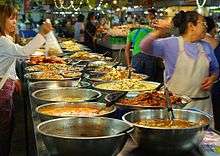
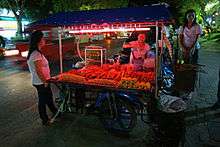
The quality and choice of street food in Thailand is world-renowned. Bangkok is often mentioned as one of the best street food cities in the world, and even called the street food capital of the world.[73][74] The website VirtualTourist says:"Few places in the world, if any, are as synonymous with street food as Thailand. For the variety of locations and abundance of options, we selected Bangkok, Thailand, as our number one spot for street food. Bangkok is notable for both its variety of offerings and the city's abundance of street hawkers."[75]
There is scarcely a Thai dish that is not sold by a street vendor or at a market somewhere in Thailand. Some specialize in only one or two dishes, others offer a complete menu that rival that of restaurants. Some sell only pre-cooked foods, others make food to order. The foods that are made to order, tend to be dishes that can be quickly prepared: quick stir fries with rice, such as kaphrao mu (spicy basil-fried minced pork)[76] or phat khana (stir fried gailan), and quick curries such as pladuk phat phet (catfish fried with red curry paste).
Noodles are a popular street food item as they are mainly eaten as a single dish. Chinese-style noodle soups, fried noodles, and fermented Thai rice noodles (khanom chin), served with a choice of different Thai curries, are popular. Nearly everywhere in Thailand you will see som tam (green papaya salad) and sticky rice sold at stalls and roadside shops. This is popularly eaten together with grilled chicken; but if the shop doesn't sell any themselves, someone else nearby will. In most cities and towns there will be stalls selling sweet roti, a thin, flat fried dough envelop, with fillings such as banana, egg, and chocolate. The roti is similar to the Malay roti canai and Singaporean roti prata, and the stalls are often operated by Thai Muslims. Sweets snacks, collectively called khanom, such as tako (coconut cream jelly), khanom man (coconut cassava cake), and khanom wun (flavored jellies), can be seen displayed on large trays in glass covered push-carts. Other sweets, such as khanom bueang and khanom khrok (somewhat similar to Dutch poffertjes), are made to order.
In the evenings, mobile street stalls, often only a scooter with a side car, drive by and temporarily set up shop outside bars in Thailand, selling kap klaem ("drinking food"). Popular kap klaem dishes sold by mobile vendors are grilled items such as sun-dried squid, meats on skewers, or grilled sour sausages, and deep-fried snacks such as fried insects or fried sausages. Peeled and sliced fruits are also sold from street carts, laid out on a bed of crushed ice to preserve their freshness. Salapao, steamed buns filled with meat or sweet beans and the Thai version of the Chinese steamed baozi, are also commonly sold by mobile vendors.
Food markets in Thailand, large open air halls with permanent stalls, tend to operate as a collection of street stalls, each vendor with their own set of tables and providing (limited) service, although some resemble the regular food courts at shopping malls and large supermarkets, with service counters and the communal use of tables. Food courts and food markets offer many of the same foods as street stalls, both pre-cooked as well as made to order. Night food markets, in the form of a collection of street stalls and mobile vendors, spring up in parking lots, along busy streets, and at temple fairs and local festivals in the evenings, when the temperatures are more agreeable and people have finished work.
The dishes sold at wet markets in Thailand tend to be offered pre-cooked. Many people go there, and also to street vendors, to buy food for at work, or to take back home. It is a common sight to see Thais carrying whole communal meals consisting of several dishes, cooked rice, sweets, and fruit, all neatly packaged in plastic bags and foam food containers, to be shared with colleagues at work or at home with friends and family. Due to the fact that many dishes are similar to those that people would cook at home, it is a good place to find regional, and seasonal, foods.
Vegetarianism in Thailand
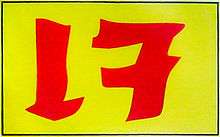

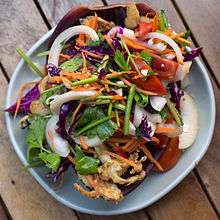
Although the Vegetarian Festival is celebrated each year by a portion of Thailand's population, and many restaurants in Thailand will offer vegetarian food during this festival period, pure vegetarian food is usually difficult to find in normal restaurants and eateries in Thailand. All traditionally made Thai curries, for instance, contain shrimp paste, and fish sauce is used as salt in many Thai dishes. At shops and restaurants that specifically cater for vegetarians, substitutes for these ingredients are used. Meat dishes are also commonly part of the alms offered to Buddhist monks in Thailand as vegetarianism is not considered obligatory in Theravada Buddhism; but having an animal killed specifically to feed Buddhist monks is prohibited.[77][78]
In most towns and cities, traditional Buddhist vegetarian fare, without any meat or seafood products of any kind and also excluding certain strong tasting vegetables and spices, is sold at specialized vegetarian restaurants which can be recognized by a yellow sign with in Thai script the word jay (Thai: เจ; IPA: [tɕeː]; pronounced as "jay", as in the word "jaywalk"; lit., "vegetarian") or ahan jay (pronounced as "ah-hahn jay"; lit. "vegetarian food") written on it in red. These restaurants serve what can be regarded as vegan food. Many Indian restaurants of the sizable Thai-Indian community will also have vegetarian dishes on offer, due to the fact that vegetarianism is held as an ideal by many followers of the Hindu faith. Indian vegetarian cuisine can incorporate dairy products and honey. Due to the increased demand for vegetarian food from foreign tourists, many hotels, guesthouses and restaurants that cater to them, will now also have vegetarian versions of Thai dishes on their menu. Pescatarians would have very few problems with Thai cuisine due to the abundance of Thai dishes which only contain fish and seafood as their source of animal protein.[79][80][81][82][83]
Thai Royal Cuisine
Originally, it referred to the food that was cooked or prepared by people living in the palace. Thai royal cuisine has become very well known from the Rattanakosin Era onwards.
Typically, Thai royal cuisine has basic characteristics that are close to the basic food prepared by general people. However, Thai royal cuisine focuses on the freshness of seasonal products. Other than that, it is crucial that the way in which Thai royal food is cooked, should be complex and delicate.
La Loubère, an envoy from France during the reign of King Narai the Great, recorded that the food at the court was generally similar to villager food. Ways that make Thai Royal cuisine different food was the beautiful presentation. For example, they served fish and chicken with the bones removed, and the vegetables were served in bite-sized portions. In addition, if beef is used, it should be tenderloin only.
There are many types of Thai royal cuisine such as ranchuan curry, nam phrik long rue, matsaman curry, rice in jasmine-flavored iced water or khao chae, spicy salad, fruit, and carved vegetable.
Thai royal cuisine is regarded as one of the cultural symbols that represents the exquisite refinement of the Thai court.
International recognition
_adjusted_cropped_resized.jpg)
Thai cuisine only became well-known worldwide from the 1960s onwards, when Thailand became a destination for international tourism and American troops arrived in large numbers during the Vietnam War period. The number of Thai restaurants went up from four in 1970s London to between two and three hundred in less than 25 years.[84] The earliest attested Thai restaurant in the United States, "Chada Thai", opened their doors in 1959 Denver, Colorado. It was run by the former newspaper publisher Lai-iad (Lily) Chittivej. The oldest Thai restaurant in London, the "The Bangkok Restaurant", was opened in 1967 by Mr and Mrs Bunnag, a former Thai diplomat and his wife, in South Kensington.[85]
The global popularity of Thai cuisine is seen as an important factor in promoting tourism to Thailand, and also increase exports of Thailand's agricultural sector. In June 2009, the Tourism Authority of Thailand organised a conference to discuss these matters at the Queen Sirikit National Convention Centre in Bangkok. TAT Governor Seree Wangpaichitr: "This conference was long overdue. The promotion of Thai cuisine is one of our major niche-market targets. Our figures show that visitors spent 38.8 billion baht on eating and drinking last year, up 16% over 1997."[86]
The Thaksin administration of Thailand (2001-2006) launched the "Kitchen of the World" campaign in 2003 to promote Thai cuisine internationally, with a yearly budget of 500 million baht. It provided loans and training for restaurateurs seeking to establish Thai restaurants overseas; established the "Thai Select" certification program which encouraged the use of ingredients imported from Thailand; and promoted integration between Thai investors, Thai Airways, and the Tourism Authority of Thailand with Thai restaurants overseas.[87]
One survey held in 2003 by the Kellogg School of Management and Sasin Institute showed that Thai cuisine ranked fourth when people were asked to name an ethnic cuisine, after Italian, French, and Chinese cuisine. When asked "what is your favourite cuisine?", Thailand's cuisine came in at sixth place, behind the three aforementioned cuisines, and Indian and Japanese cuisine.[84]
In the list of the "World's 50 most delicious foods", compiled by CNN in 2011, som tam stands at place 46, nam tok mu at 19, tom yam kung at 8, and massaman curry stands on first place as most delicious food in the world.[88] In a reader's poll held a few months later by CNN, mu nam tok came in at 36, Thai fried rice at 24, green curry at 19, massaman curry at 10, and Thai som tam, pad Thai, and tom yam kung at six, five, and four.[89]
In 2012, the British Restaurant Magazine, included "Nahm Bangkok" of chef David Thompson in its yearly list of The World's 50 Best Restaurants.[90]
Awards
Thai chefs of the Thailand Culinary Academy took second place in the Gourmet Team Challenge (Practical) of the FHC China International Culinary Arts Competition 14 in Shanghai, China on 14–16 November 2012. They won the IKA Culinary Olympic 2012 competition held in Erfurt, Germany between 5–10 October 2012, where they received four gold and one silver medal.[91]
In 2011, the James Beard Foundation Award for Best Chef in Northwestern United States, was presented to Andy Ricker of restaurant "Pok Pok" in Portland, Oregon, and for Best Chef in Southwestern United States to Saipin Chutima of restaurant "Lotus of Siam" in Winchester, Nevada.[92]
Michelin stars
Three restaurants that specialize in Thai cuisine, but are owned by non-Thai chefs, have received Michelin stars:
- 2002 - 2011 "Nahm" in London, run by chef David Thompson[93][94]
- 2009 - "Kiin Kiin" in Copenhagen, run by chef Henrik Yde-Andersen and Lertchai Treetawatchaiwong[95]
- 2015 - "Pok Pok NY" in New York City, run by chef Andy Ricker[96]
Culinary tours and cooking courses
.jpg)
Culinary tours of Thailand have gained popularity in recent years. Alongside other forms of tourism in Thailand, food tours have carved a niche for themselves. Many companies offer culinary and cooking tours of Thailand and many tourists visiting Thailand attend cooking courses offered by hotels, guesthouses and cooking schools.
Thai Delicious project
Thailand's National Innovation Agency (NIA), a public organization under the Thai Ministry of Science and Technology, is spearheading a 30 million baht (US$1 million),[97] effort by the government to:
- Develop Thai recipes with "authentic taste" and establish them as standard recipes
- Develop biosensor equipment to analyze and evaluate taste and flavors
- Develop institutional food (ready-to-cook products) based on the standardized recipes to meet the demand for Thai food in foreign countries
- Provide a food certification service as well as training for local and foreign chefs working in Thai restaurants worldwide[98]
The agency has posted 11 "authentic" recipes for tom yum gung (nam sai), tom yum gung (nam khon), pad Thai, Massaman curry, kaeng kiew wan (green curry), kaeng lueng (southern Thai sour curry), Golek chicken sauce, khao soi, sai oui (northern Thai sausage), nam prik noom (green pepper chili paste), and nam prik aong (northern Thai chili paste).[99] These recipes were featured at a gala dinner promoting "Authentic Thai Food for the World", held at the Plaza Athénée Hotel Bangkok on 24 August 2016 at which Thailand's minister of industry was the honored guest.[100] By 2020, Thai Delicious plans to post over 300 Thai food recipes.[101]
To determine authenticity, Thai researchers developed the "e-delicious machine", described as "...an intelligent robot that measures smell and taste in food ingredients through sensor technology in order to measure taste like a food critic."[102]The machine evaluates food by measuring its conductivity at different voltages. Readings from 10 sensors are combined to produce a chemical signature. Because the machine cannot judge taste, the food is compared with a standard derived from a database of popular preferences for each dish. For tom yam, the spicy soup flavored with Kaffir lime leaves and coriander, researchers posted notices at Chulalongkorn University in Bangkok, requesting 120 tasters. The tasters—students, university staff, and area workers—were paid a few baht for their opinions. They were served 10 differently prepared soups and rated each one. The winning soup was declared the standard, and its chemical characteristics were programmed into the machine. When testing food, the machine returns a numerical score from one to 100. A score lower than 80 is deemed "not up to standard". The machine cost about US$100,000 to develop.[97] Restaurants that follow officially sanctioned recipes can affix a "Thai Delicious" logo to their menus.[97]
The Thai Delicious project has been criticized, the main rationale being that, "Standardisation is the enemy of Thai food."[103]
See also
- List of Thai dishes (includes names in Thai script)
- List of Thai ingredients (includes names in Thai script)
- List of Thai khanom
- List of Thai restaurants
- Thai curry
- Thai salads
- Hmong cuisine
References
- ↑ Tucker, Ian (19 September 2010). "One night in Bangkok on the trail of Thai street food". The Observer. London. Retrieved 29 October 2013.
- 1 2 The Principles of Thai Cookery: Chef McDang:.
- ↑ "อาหารไทย".
- ↑ Tim Cheung (7 September 2011). "Your pick: World's 50 best foods". CNNGo. Retrieved 19 May 2015.
- ↑ http://www.thaicarving.co.uk/php/history.php
- ↑ "Thai Cuisine". Zomzaa.com. Retrieved 29 Oct 2013.
- 1 2 "Southern Thai Rice Salad - Khao Yam (ข้าวยำ) and a Chat with Jitlada Restaurant in Los Angeles". Shesimmers.com. 28 February 2011. Retrieved 29 October 2013.
- ↑ "Thai Food". thaiso.com. 20 January 2010. Retrieved 29 October 2013.
- ↑ "Thai Food Blog: Royal Thai Cuisine". Faafood.net. Retrieved 29 Oct 2013.
- ↑ McDang, Chef (15 July 2011). "Chef McDang: The myth of 'royal' Thai cuisine". Cnngo.com. Retrieved 29 October 2013.
- ↑ "Thai Food and Culture". Thai-recipes-today.com. 13 Sep 2013. Retrieved 29 October 2013.
- ↑ Wongcha-Um, Panu. "What is Thai Cuisine? Thai Culinary Identity Construction From The Rise of the Bangkok Dynasty to Its Revival".
- ↑ "CNNGo Best Eats: Bangkok's best Teochew restaurant". Cnngo.com. 23 Nov 2010. Retrieved 29 Oct 2013.
- ↑ "Singapore Chinese Food (Recipes)". Singaporelocalfavourites.blogspot.nl. 13 June 2011. Retrieved 29 October 2013.
- ↑ "Royal Thai Consulate General: Thai Cuisine". Thaicongenvancouver.org. Retrieved 29 Oct 2013.
- ↑ "How To Make: (Southern Style) Kaeng Som". Austin Bush Photography. 25 January 2006. Retrieved 29 October 2013.
- ↑ Leela. "Shesimmers: Massaman (Matsaman) Curry Recipe (แกงมัสมั่น)".
- ↑ "Beef Matsaman Curry". Thaifoodmaster. 17 September 2009. Retrieved 29 October 2013.
- ↑ "Chapter3". Thailand.prd.go.th. Archived from the original on 15 October 2013. Retrieved 29 October 2013.
- ↑ Cummings, Joe (2000). World Food: Thailand. Melbourne, Australia: Lonely Planet. p. 79.
- ↑ Archived 20 May 2013 at the Wayback Machine.
- ↑ "Lanna Food: Sticky Rice Ball".
- ↑ "Sunate Suwanlaong: ''Historical Development of Consumerism in Thai Society'' p.95" (PDF). Retrieved 29 October 2013.
- ↑ "How to Eat Thai Chili Relishes กินข้าวกับน้ำพริก(สิจ๊ะถึงได้สะได้สวย)".
- ↑ "First Time Eating New Food and International Cuisine at Restaurants". The Food Virgin. Retrieved 29 October 2013.
- ↑ "Thai Food - Characteristics of Thai Food by". Sawadee.com. Retrieved 29 October 2013.
- ↑ "Thailand". Ethnologue.
- ↑ "Agriculture or agribusiness? Thai farmers search for viable alternatives".
- ↑ "Thai Fish-Eating Tradition".
- ↑ Anna Harriette Leonowens, The English Governess at the Siamese Court, 1870, p. 3
- ↑ , (1 February 2005). "FAO National Aquaculture Sector Overview (NASO)".
- ↑ Elsinburg, Andrea. "Have You Eaten Rice Yet?". San Diego Reader. Retrieved 2015-09-22.
- ↑ Kisner, Connie. "Climate Change in Thailand: Impacts and Adaptation Strategies". Climate Institute. Retrieved 2015-01-06.
- ↑ Akkasit Jongjareonrak, et al. Antioxidant activity of fermented fish viscera (Tai-Pla) from short-bodied mackerel, Faculty of Agro-Industry, Prince of Songkhla University, Hat Yai, Songkhla, Thailand
- ↑ "น้ำพริกไตปลา". The-than.com. Retrieved 29 October 2013.
- ↑ "Nampu". Lanna Food. Northern Thai Information Center, Chiang Mai University Library. Retrieved 2014-11-03.
- ↑ De la Loubère, The Kingdom of Siam, p.35
- ↑ "Phrik lap". Lanna Food. Northern Thai Information Center, Chiang Mai University Library. Retrieved 2014-11-03.
- ↑ "The Vegetable Sector in Thailand". Fao.org. Retrieved 29 October 2013.
- ↑ "Thai vegetables". Samui.sawadee.com. Archived from the original on 28 August 2013. Retrieved 29 October 2013.
- ↑ The text makes it is clear that "India" here means the Indies: both India and Southeast Asia.
- ↑ Crawfurd, John (1830). Journal of an embassy from the Governor-General of India to the courts of Siam and Cochin-China : exhibiting a view of the actual state of those kingdoms. London: Henry Colburn and Richard Bentley. p. 421.
- ↑ "Fruit Dips, Thai Style".
- ↑ "Nam Prik Long Rua".
- ↑ "Dine at the museum". Bangkok Post. 17 December 2013.
- ↑ "World Durian Festival 2005". Thailand News -- Thailand official news and information. Foreign Office, The Government Public Relations Department. 5 June 2005. Archived from the original on 7 January 2009. Retrieved 20 November 2008.
- ↑ "Thailand's Durian growing areas". Food Market Exchange. 2003. Retrieved 20 November 2008.
- ↑ "Committee On Commodity Problems". FAO. 8 December 2001. Retrieved 29 October 2013.
- ↑ "Uttaradit local government website: Langsat Festival".
- ↑ "Leaf-Wrapped Salad Bites (Miang Kham)". Rasa Malaysia.
- ↑ "Isan Thai Cuisine - Temple of Thai".
- ↑ "Coconut".
- ↑ The Eleventh National Economic and Social Development Plan (2012-2016). Office of the National Economic and Social Development Board. 26 October 2011. Retrieved 1 April 2016.
- ↑ "Fruit and veggies 'still contaminated'". Bangkok Post. 7 October 2016. Retrieved 7 October 2016.
- ↑ Fernquest, Jon (2016-05-04). "Pesticides in fruits & vegetables: Govt quality mark fails test". Bangkok Post. Retrieved 7 October 2016.
- ↑ Frederickson, Terry (2014-08-19). "Q-mark: not a guarantee of food safety". Bangkok Post. Retrieved 7 October 2016.
- ↑ "Panel blasts 'halal' pork logo". Bangkok Post. 6 October 2016. Retrieved 7 October 2016.
- ↑ "One-third of fish sauces found below standard". Bangkok Post. 6 October 2016. Retrieved 8 October 2016.
- ↑ "Thai Breakfast: 13 of the Most Popular Dishes". Eating Thai Food. 24 January 2012. Retrieved 29 October 2013.
- ↑ "Breakfast In Asia". MrBreakfast.com. Retrieved 29 October 2013.
- ↑ "Bangkok - A Taste of Pa Thong Ko (Thai Crullers) in Yaowarat - China & Southeast Asia - Chowhound". Chowhound.chow.com. Retrieved 29 October 2013.
- ↑ "Khanomchin nam-ngeo - Lanna Food - Northern Thai Information Center, Chiang Mai University Library".
- 1 2 3 CulinaryGods.com 2015
- 1 2 3 4 Culinarygods Isaan
- ↑ Chef Todd and Onuma Scire Culinarygods Isaan
- ↑ Chef Onuma Scire CulinaryGods.com
- ↑ Onuma Scire CulinaryGods.com Isaan
- ↑ CulinaryGods Isaan
- 1 2 3 Charoenpo, Anucha (2014-01-06). "Ancient ice-cream still worth a lick". Bangkok Post. Retrieved 7 October 2016.
- 1 2 "ย้อนตำนานไอศกรีม สู่วัฒนธรรมการกินที่หลากหลาย" . http://www.manager.co.th/Daily/ViewNews.aspx?NewsID=9550000047164 17 เมษายน 2555 11:36 น.
- ↑ "Shatter the Looking Glass Magazine". Shatterthelookingglass.com. Retrieved 29 October 2013.
- ↑ "Aep i-huak - Lanna Food - Northern Thai Information Center, Chiang Mai University Library".
- ↑ "The 10 best street food cities in the world, per VirtualTourist.com, Frommer's". NY Daily News.
- ↑ "The Hairy Bikers' Asian Adventure, Thailand - Bangkok and the Central Plains". BBC.
- ↑ "Top Ten Cities for Street Food". Virtual Tourist.
- ↑ "The world's best street food". The Guardian. London. 24 February 2012.
- ↑ "Buddhism and Eating Meat". Urbandharma.org. Retrieved 29 October 2013.
- ↑ "Buddhism Views On Vegetarianism And Non-Vegetarianism". Soulcurrymagazine.com. 14 January 2008. Retrieved 29 October 2013.
- ↑ "Vegetarian and Vegan Travel Guide - Thailand". Circle Our Earth. Retrieved 29 October 2013.
- ↑ Wiens, Mark (19 January 2012). "The vegetarian's guide to Thailand travel". Cnngo.com. Retrieved 29 October 2013.
- ↑ "Vegetarian Thai cuisine or just plain: how to cook vegetarian Thai Food". Vegetarian.information.in.th. 1 January 2004. Retrieved 29 October 2013.
- ↑ "9 Gods Invited for the Vegetarian Festival". Thaibuddhist.com. 27 September 2011. Retrieved 29 October 2013.
- ↑ Dicum, Gregory (23 February 2009). "In Thailand, Vegetarians Find a Place at the Table". The New York Times.
- 1 2 Sunanta, Sirijit (14–16 October 2005). "The Globalization of Thai Cuisine" (PDF). University of British Columbia. Toronto: Paper presented at the Canadian Council for Southeast Asian Studies Conference, York University. pp. 3–4. Archived from the original (PDF) on 26 December 2013.
- ↑ "FAQs: Asian-American cuisine". Thefoodtimeline.org. Retrieved 7 October 2014.
- ↑ "Country Information - THAILAND: TAT PROMOTES TOURISM BY PROMOTING THAI CUISINE".
- ↑ Sunanta, Sirijit (14–16 October 2005). "The Globalization of Thai Cuisine" (PDF). University of British Columbia. Toronto: Paper presented at the Canadian Council for Southeast Asian Studies Conference, York University. pp. 10–12. Archived from the original (PDF) on 26 December 2013.
- ↑ CNNGo staff 2 (21 July 2011). "50 best foods in the world". Cnngo.com. Retrieved 29 October 2013.
- ↑ Cheung, Tim (7 September 2011). "World's 50 best foods: Readers' picks". Cnngo.com. Retrieved 29 October 2013.
- ↑ "The World's 50 Best Restaurants". Restaurant Magazine. Archived from the original on 21 September 2014. Retrieved 6 October 2014.
- ↑ วันที่ 19 พฤศจิกายน พ.ศ. 2555 เวลา 07:29:18 น. ""เชฟไทย"นำสุดยอดเมนู"กระเพราแกะ-ผัดไทย-ลาบ-ส้มตำ"คว้าชัยเวทีอาหารที่เซี่ยงไฮ้ : มติชนออนไลน์". Matichon.co.th. Retrieved 29 October 2013.
- ↑ "Restaurant and Chef Awards 2011". James Beard Foundation. Retrieved 6 October 2014.
- ↑ "Michelin star for Thai restaurant". London Evening Standard. Retrieved 6 October 2014.
- ↑ "Nahm London loses its Michelin star, but should Bangkok care?". CNN Travel. Retrieved 6 October 2014.
- ↑ "Restaurants in Copenhagen with Michelin stars 2009". AOK.dk. Retrieved 6 October 2014.
- ↑ "New York's Michelin-Starred Restaurants Announced For 2015". Forbes. Retrieved 6 October 2014.
- 1 2 3 Fuller, Thomas (2014-09-28). "You Call This Thai Food? The Robotic Taster Will Be the Judge". New York Times. Retrieved 8 September 2016.
- ↑ "Innovation for Kitchen to the World". National Innovation Agency (Thailand). Retrieved 8 September 2016.
- ↑ "Thai Standard Recipe [sic]". National Innovation Agency (NIA). Retrieved 8 September 2016.
- ↑ "National Food Institute, the Ministry of Industry Organized Gala Dinner 'Authentic Thai Food for the World' to Upgrade 'Rod Thai Tae' [True Thai Taste] Food Standard Worldwide". Postup News. 2016-08-25. Retrieved 8 September 2016.
- ↑ "About Us". Thai Delicious International. Retrieved 8 September 2016.
- ↑ Theeboom, Sarah (Sep 29, 2014). "The Thai Government is Trying to Standardize Deliciousness". First We Feast. Retrieved 8 September 2016.
- ↑ "Thai food, made bland". Bangkok Post. 7 September 2016. Retrieved 8 September 2016.
Further reading
- Vatcharin Bhumichitr, The Essential Thai Cookbook, 192 pages, New York: Clarkson N. Potter Inc., 1994, ISBN 978-0517596302
- Joe Cummings, Lonely Planet World Food Thailand, 288 pages, Lonely Planet Publications, 2000, ISBN 978-1-86450-026-4
- Leela Punyaratabandhu, Simple Thai Food: Classic Recipes from the Thai Home Kitchen, 236 pages, Berkeley: Ten Speed Press, 2014, ISBN 978-1607745235
- Andy Ricker, Pok Pok: Food and Stories from the Streets, Homes, and Roadside Restaurants of Thailand, 304 pages, Berkeley: Ten Speed Press, 2013, ISBN 978-1607742883
- ML Sirichalerm Svasti (Chef McDang), The Principles of Thai Cookery, 304 pages, McDang dot Com Company, Limited, 2010, ISBN 978-6-16906-010-9
- David Thompson, Classic Thai Cuisine, 145 pages, Berkeley: Ten Speed Press, 1993, ISBN 0-89815-563-0
External links
| Wikibooks Cookbook has a recipe/module on |
| Wikimedia Commons has media related to Cuisine of Thailand. |
- Thaifoodmaster - Step by Step recipes, Thai cuisine history and Thai culture - Bilingual
- Cuisine of Thailand at DMOZ lists a selection of Thai recipe websites
- http://www.thaifoodmaster.com/what-is-thai-cuisine
- Thai government public relations department: Famous Thai dishes
- Chiang Mai University: recipes from Northern Thailand

